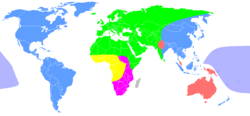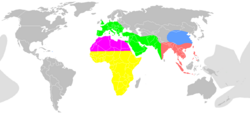Encyclopedia, Difference between revisions of "Carleton S. Coon" - New World
({{Contracted}}) |
(replacing map) |
||
| Line 28: | Line 28: | ||
Coon’s work is often regarded as controversial. His explanation of multilinear racial development and his emphasize on the white race led many commentators to criticize him of resembling to the [[scientific racism]] of the early twentieth century. His proponents on the other side see Coon’s work as an attempt to scientifically explain racial proliferation and development. | Coon’s work is often regarded as controversial. His explanation of multilinear racial development and his emphasize on the white race led many commentators to criticize him of resembling to the [[scientific racism]] of the early twentieth century. His proponents on the other side see Coon’s work as an attempt to scientifically explain racial proliferation and development. | ||
| − | + | {{Template:Carleton S. Coon Racial Definitions}} | |
In 1962, he published his magnum opus ''The Origin of Races''. The book was widely denounced in anthropological circles, as physical anthropology had changed greatly since his time as an undergraduate at Harvard. Contemporary researchers such as [[Sherwood Washburn]] and [[Ashley Montagu]] were heavily influenced by the [[modern synthesis]] in biology and [[population genetics]], as well as a [[Franz Boas|Boasian]] revolt against typological racial thinking. The human species are now seen as a continuous '''serial''' progression of populations rather than the five '''parallel''' genetically distinct races. Based on the amount of genetic variation between races that is slight, modern scientists believer that the racial differences are of recent origin. | In 1962, he published his magnum opus ''The Origin of Races''. The book was widely denounced in anthropological circles, as physical anthropology had changed greatly since his time as an undergraduate at Harvard. Contemporary researchers such as [[Sherwood Washburn]] and [[Ashley Montagu]] were heavily influenced by the [[modern synthesis]] in biology and [[population genetics]], as well as a [[Franz Boas|Boasian]] revolt against typological racial thinking. The human species are now seen as a continuous '''serial''' progression of populations rather than the five '''parallel''' genetically distinct races. Based on the amount of genetic variation between races that is slight, modern scientists believer that the racial differences are of recent origin. | ||
Revision as of 21:15, 20 June 2006
Carleton Stevens Coon (born June 23, 1904 – died June 3, 1981) was an American physical anthropologist and archeologist, best remembered for his work on the origin of races.
Life
Carleton Coon was born in Wakefield, Massachusetts to a wealthy Yankee family. He developed an interest in prehistory, and decided to attend Phillips Academy in Andover. There he studied hieroglyphics, at the same time developing a proficiency in ancient Greek language. Coon went on to study Egyptology at Harvard, with George Reisner. However he, like many students, was swayed to the field of anthropology by Earnest Hooton and he graduated magna cum laude in 1925.
Coon continued on in Harvard, making the first of many trips to North Africa in 1925 to conduct fieldwork in the Rif area of Morocco, which was still politically unsettled after a rebellion of the local populace against the Spanish. Coon earned his Ph.D. in 1928 and returned to Harvard as a lecturer and later a professor. He thought at Harvard from 1934 to 1948.
In 1939 he published a revision of William Z. Ripley's 1899 The Races of Europe, which brought great success. Coon, like his mentor Earnest Hooton, wrote widely for a general audience, and his books were well accepted. He continued his field studies and published several novels and fictionalized accounts of those trips - to North Africa, including The Riffians, Flesh of the Wild Ox, Measuring Ethiopia, and A North Africa Story: The Anthropologist as OSS Agent. This last book was an account of his work during World War II, for the United States Office of Strategic Services, which involved espionage and the smuggling of arms to French resistance groups in German-occupied Morocco under the guise of anthropological fieldwork. This practice was severely criticized later by the scientific community in the name of scientific ethics.
In 1948, Coon left Harvard to take up a position as Professor of Anthropology at the University of Pennsylvania, which had an excellent museum attached to it. Throughout the 1950s he produced a series of academic papers, as well as many popular books for the general reader, like his most popular The Story of Man (1954). From 1948 to 1951 Coon did research in Iraq and Iran, and in 1954 in Afghanistan. He served as president of the American Association of Physical Anthropologists in 1961-1962. He conducted several more expeditions to Africa in 60s. Coon died in 1981 in Gloucester, Massachusetts.
Work
Coon's main hypothesis was that modern humans - Homo sapiens – arose through five separate lines from Homo erectus, in five separate geographical locations. Coon writes:
- "as each subspecies, living in its own territory, passed a critical threshold from a more brutal to a more sapient state", thus providing origins in deep time for his five races of mankind”.
Coon attempted to use Darwin's theory of natural selection to explain the differing physical characteristics of various racial groups. Coon believed that different racial types struggled for domination over each other, same as the natural selection applies to other animal species. In their evolutionary development different races reached stage of Homo sapiens at different times, what explains why races achieved different level of civilization. He writes in his The Races of Europe:
- " historically different strains in one population have showed differential survival values and often one has reemerged at the expense of others (in Europeans)"
Coon’s work is often regarded as controversial. His explanation of multilinear racial development and his emphasize on the white race led many commentators to criticize him of resembling to the scientific racism of the early twentieth century. His proponents on the other side see Coon’s work as an attempt to scientifically explain racial proliferation and development.
|
In 1962, he published his magnum opus The Origin of Races. The book was widely denounced in anthropological circles, as physical anthropology had changed greatly since his time as an undergraduate at Harvard. Contemporary researchers such as Sherwood Washburn and Ashley Montagu were heavily influenced by the modern synthesis in biology and population genetics, as well as a Boasian revolt against typological racial thinking. The human species are now seen as a continuous serial progression of populations rather than the five parallel genetically distinct races. Based on the amount of genetic variation between races that is slight, modern scientists believer that the racial differences are of recent origin.
The 1960s were a controversial time for racial theories, and Coon's cousin Carleton Putnam suggested that Coon's work, among others, justified racial segregation. Coon stepped down as President of the American Association of Physical Anthropologists in disgust after the association voted to censure Putnam's book Race and Reason: A Yankee view. Coon continued to write and defend his work until his death in 1981.
Legacy
Coon made contributions to both archeology and to cultural and physical anthropology. He conducted numerous studies all around the world on the origins and variations of human racial types. His ideas were both refuted and appraised, and the controversy about them still continues. Despite of everything Coon was a real pioneer of physical anthropology. In his studies he advocated holistic approach to anthropology, incorporating into the research elements of ethnography, social anthropology, physical anthropology, and archeology.
Bibliography
- Coon, Carleton S. (1951). Caravan: The Story of the Middle East: A North Africa Story. Henry Holt and Co
- Coon, Carleton S. (1957). Seven Caves: Archaeological Exploration in the Middle East. Cape. ISBN 0224601113
- Coon, Carleton S. (1962). The Origin of Races. Random House. ISBN 0394301420
- Coon, Carleton S. (1962). The Story of Man: From the First Human to Primitive Culture and Beyond. Random House. ISBN 0394447395
- Coon, Carleton S. (1965/1973). Living Races of Man. Random House. ISBN 0394433726
- Coon, Carleton S. (1968). Yengema Cave Report (University Museum Monographs, No 31). University Museum Publications. ISBN 0934718237
- Coon, Carleton S. (1969). The Story of Man. New York : Knopf. ISBN 0394447395
- Coon, Carleton S. (1972). The Races of Europe. Greenwood Press Reprint. ISBN 0837163285.
- Coon, Carleton S. (1974). Mountains of Giants: A Racial and Cultural Study of the North Albanian Mountain Ghegs. Periodicals Service Co. ISBN 0527012580
- Coon, Carleton S. (1977). The Hunting Peoples. Penguin (Non-Classics). ISBN 0140218874
- Coon, Carleton S. (1981). Adventures and Discoveries: The Autobiography of Carleton S. Coon. Prentice-Hall. ISBN 0130140279
- Coon, Carleton S. (1982). Racial Adaptations. Burnham, Inc. ISBN 0882298062
- Coon, Carleton S.; Garn, Stanley M. & Birdsell, Joseph B. (1981). Races: A Study of the Problems of Race Formation in Man. Greenwood Press Reprint. ISBN 0313228787
ReferencesISBN links support NWE through referral fees
- Harrington, Spencer P.M. (1999). Hybrid Humans? Archaeological Institute of America, 52, 4. Full text on [1]
- Howells, W.W. (1989). Carleton Coon, 23 June, 1904 – 3 June, 1981 (obituary). In Biographical Memoirs of the National Academy of Sciences of the United States of America, vol.58, 108-131.
- Dobzhansky, Theodosius, Montagu, Ashley & Coon, C.S. (1963). Two Views of Coon's Origin of Races (with Comments by Coon and Replies). Current Anthropology, 4, 4. pp. 360-367.
External links
- Carleton Stevens Coon Papers, - National Anthropological Archives, Smithsonian Institution
- The Hybrid Child - skeleton of a child found in Portugal that is a mix of Homo-sapiens and Neanderthal
- Bernier (1984) A New Division of the Earth. - example of a Euro-centric view on races
- Races of Men - Full text of Coon's book
- Races today - Some links on racial reality
Credits
New World Encyclopedia writers and editors rewrote and completed the Wikipedia article in accordance with New World Encyclopedia standards. This article abides by terms of the Creative Commons CC-by-sa 3.0 License (CC-by-sa), which may be used and disseminated with proper attribution. Credit is due under the terms of this license that can reference both the New World Encyclopedia contributors and the selfless volunteer contributors of the Wikimedia Foundation. To cite this article click here for a list of acceptable citing formats.The history of earlier contributions by wikipedians is accessible to researchers here:
The history of this article since it was imported to New World Encyclopedia:
Note: Some restrictions may apply to use of individual images which are separately licensed.

